Brass Knuckles History
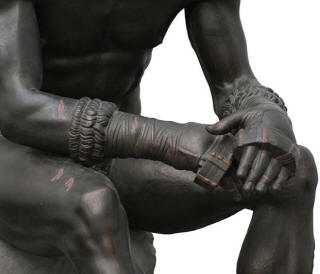 In the United States they're known as "brass knuckles", also
sometimes called "knucks" or "knuckle dusters" (more
common in British English), and translated from German they are
called "punch rings". A less known form of artificial knuckles are known as "sap
gloves".
Sap gloves are leather gloves filled with bars of lead or lead powder.
For years boxers have used them secretly, along with brass knuckles, to
gain an unfair advantage over their opponents. In the United States they're known as "brass knuckles", also
sometimes called "knucks" or "knuckle dusters" (more
common in British English), and translated from German they are
called "punch rings". A less known form of artificial knuckles are known as "sap
gloves".
Sap gloves are leather gloves filled with bars of lead or lead powder.
For years boxers have used them secretly, along with brass knuckles, to
gain an unfair advantage over their opponents.
Brass
knuckles are commonly believed to have evolved from the ancient
Roman "caestus", a type of glove or hand guard made from
leather and metal used during boxing matches in gladiatorial events.
Unlike modern day boxing gloves which are used to muffle the fist of
fighters and thus lessen bodily harm, the caestus was used to
intensify the damage caused by a punch or blow.
A cestus is an ancient battle glove. In effect, it is the
Classic world's equivalent to brass knuckles, sometimes used in
pankration. The first version of a cestus was a series of
leather thongs that were tied over the hand. Greeks used them in
their hand-to-hand competitions, where only knock out mattered.
In Roman Latin, cestus referred to leather that was wrapped or bound
over anything, including items like belts. Romans modified the
leather thongs by adding metal parts, including studs and iron
plates. Some of them had fixed spikes over the knuckles.
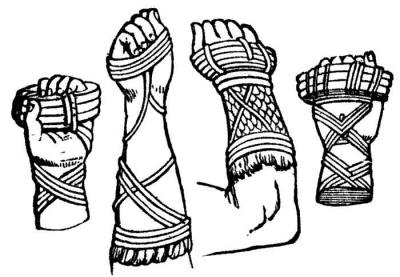
More dangerous versions of the same weapon included the myrmex or
"limb-piercer", and the originally Greek sphairai, thin leather
thongs with cutting blades.
Cesti were usually used in gladiator bouts where otherwise unarmed
combatants - usually slaves - fought to the death. This form of
boxing became increasingly bloody until the cestus was officially
banned in the 1st century BC. Hand-to-hand fighting was banned in
393 AD.
The most famous depiction of the cestus in sculpture is The Boxer of
Quirinal, in Rome. The sitting figure is wearing cesti on his hands.
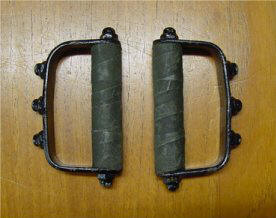 A
similar weapon, the "tekko", is one of the traditional
weapons of kobudo, a martial art from Okinawa, Japan. They
were used mostly by martial
artists, and they are still used today and are usually fashioned out of
wood, metal or whatever else may be handy. A
similar weapon, the "tekko", is one of the traditional
weapons of kobudo, a martial art from Okinawa, Japan. They
were used mostly by martial
artists, and they are still used today and are usually fashioned out of
wood, metal or whatever else may be handy.
Tekko was originally a type of horseshoe. It is said that farmers
kept one always on hand, and it could be a very effective tool in
fighting any enemy immediately. It was also handy to carry. It
went through various modifications as a self-defense tool to be used
whenever a situation calls for an instant reaction until it acquired
its present shape.
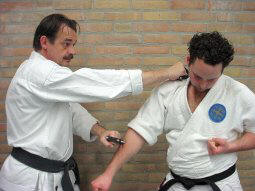 Historically, brass knuckles are weapons used in hand-to-hand
combat. Basically, brass knuckles are pieces of metal,
usually steel despite their name, shaped to fit around the knuckles.
Designed to deliver the force of punches through a smaller and
harder contact area they result in greater tissue disruption and
increased likelihood of fracturing the victim's bones on impact.
Also, the wielder of such a weapon may punch harder than normal,
exacerbating damage even further, due to reduced subconscious
anxiety about harming their own hands when striking. Historically, brass knuckles are weapons used in hand-to-hand
combat. Basically, brass knuckles are pieces of metal,
usually steel despite their name, shaped to fit around the knuckles.
Designed to deliver the force of punches through a smaller and
harder contact area they result in greater tissue disruption and
increased likelihood of fracturing the victim's bones on impact.
Also, the wielder of such a weapon may punch harder than normal,
exacerbating damage even further, due to reduced subconscious
anxiety about harming their own hands when striking.
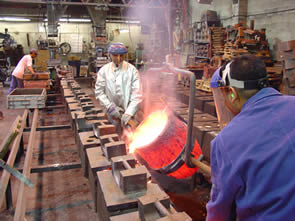 Often made in factories in Pakistan or China, brass knuckles
typically are constructed out of aluminum or steel . Chrome or
brass paint, or whatever color is then applied. Truly brass
brass knuckles are rare due to the weight and expense of brass,
which can range up to $80 + for one pair! Some knuckles are also
made of plastic which can serve the same purpose as the metal
variety but are much lighter and less likely to be detected.
You can check and see that we sell a few of these. Often made in factories in Pakistan or China, brass knuckles
typically are constructed out of aluminum or steel . Chrome or
brass paint, or whatever color is then applied. Truly brass
brass knuckles are rare due to the weight and expense of brass,
which can range up to $80 + for one pair! Some knuckles are also
made of plastic which can serve the same purpose as the metal
variety but are much lighter and less likely to be detected.
You can check and see that we sell a few of these.
All of our
metal knuckles are made of steel. Some of our competition
sells only aluminum knuckles, so watch out.
Common varieties are spiked knuckles, "fat boys", "wedding rings",
brass knuckles donned with a longhorn steer on the knuckles, brass
knuckles with lions or skulls on the knuckles, etc..
Spiked knuckles are seen to be of the most vicious variety of brass
knuckles as they not only can shatter bone into fragments but will
shred tissue. The length of the spikes varies from as small as a
quarter of an inch to up to 6 inches. Shorter spikes emphasize the
impact of the brass knuckle while longer blades are used solely to
inflict tissue damage.
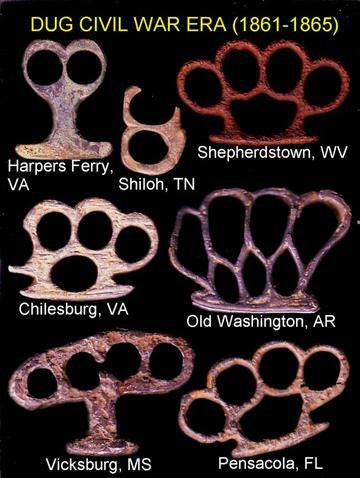
For more info on how to
use brass knuckles, and about safety,
and also different creative uses, click
Brass Knuckles Information...
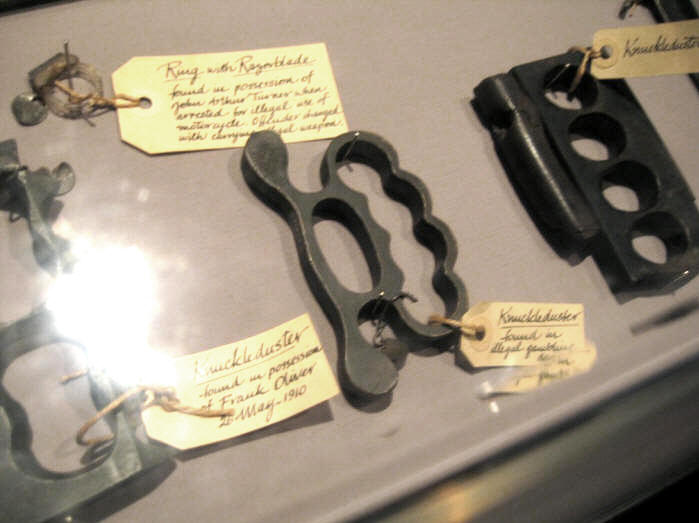
|